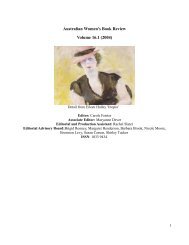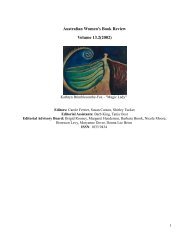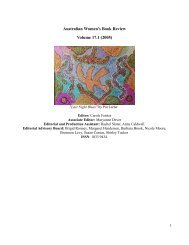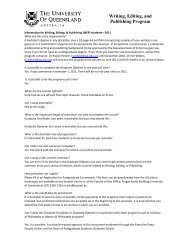Australian Women's Book Review Volume 14.1 - School of English ...
Australian Women's Book Review Volume 14.1 - School of English ...
Australian Women's Book Review Volume 14.1 - School of English ...
Create successful ePaper yourself
Turn your PDF publications into a flip-book with our unique Google optimized e-Paper software.
missionaries and evangelists' (p.xi). As well as her work as a health pr<strong>of</strong>essional in Aboriginal<br />
communities, this evangelical heritage shapes her interest in Aboriginal Christianity and informs her<br />
measured critique <strong>of</strong> the colonising discourses <strong>of</strong> contemporary Christian evangelists in the Kimberley.<br />
Although there have been anthropological studies <strong>of</strong> Aborigines and Christianity in the past,<br />
'Aboriginal Christianity' as such has not been a subject for anthropological investigation. The readiness<br />
to acknowledge Aboriginal Christianity as a possibility within Christianity parallels the emergence <strong>of</strong><br />
Asian, Black American, liberationist, and feminist (theological) movements that challenge and reveal<br />
as partial the universalising claims <strong>of</strong> Western Christianity (pp. 8-9).<br />
McDonald for her part is concerned less with why many Aboriginal people become Christians than<br />
with what meanings they make within Christianity. She asks: 'How did a land-based people who<br />
celebrate in ritual their embodied relationship to a fecund universe, embrace a Hellenistic<br />
Mediterranean religion <strong>of</strong> displaced peoples?' (p. 2). Blood, Bones and Spirit considers the ways in<br />
which a universalist religion <strong>of</strong> placelessness, as she understands Western Christianity to be, affects and<br />
is in turn affected by the encounter with Aboriginal spiritualities <strong>of</strong> place.<br />
While this book is written in a clear and engaging style, it is not always an easy book to read. For this<br />
reader, McDonald's descriptions <strong>of</strong> the overtly colonising discourse <strong>of</strong> the AOG missionaries were<br />
particularly disturbing. She makes note, too, that what might seem more benign traditions such as<br />
Roman Catholic, Uniting Church and Anglican, may continue the colonising process in more subtle<br />
ways. On the surface the UAM appears less conservative than the AOG and its attitudes to traditional<br />
Aboriginal cultural practices appear somewhat less negative. Nevertheless, the accommodation <strong>of</strong><br />
Aboriginal cultural practice to white Christian expectations does not correlate directly with the level <strong>of</strong><br />
conservatism and overt racism underlying and expressed in those expectations. Differences between the<br />
experience <strong>of</strong> the adherents in terms <strong>of</strong> their town or station background and their earlier experience <strong>of</strong><br />
colonisation are also key factors affecting the way in which Aboriginal culture is valued and<br />
maintained in the context <strong>of</strong> the competing expectations and claims <strong>of</strong> Western Christianity.<br />
For McDonald, however, many <strong>of</strong> her informants expressed attitudes to their own race which suggested<br />
to her that they had internalised the racist attitudes <strong>of</strong> the contemporary colonising missionaries. In<br />
particular, both missionaries and Aboriginal adherents used the language <strong>of</strong> 'black' and 'white' to<br />
describe respectively the pre-Christian sinful person (black inside and out) and the Christian person<br />
(white inside). In addition, McDonald describes an ongoing demonisation by the AOG missionaries <strong>of</strong><br />
Aboriginal cultural practices. It can be difficult to judge the internal attitudes <strong>of</strong> another - this involves<br />
in a sense speaking for the other. Nonetheless, the evidence that McDonald presents, replaying in part<br />
the ongoing tragedy and injustice <strong>of</strong> colonisation and in particular the shame engendered in Aboriginal<br />
people through exposure to racist ideologies, is deeply disturbing.<br />
But Blood, Bones and Spirit also challenges an easy understanding <strong>of</strong> Aboriginal experience <strong>of</strong><br />
Christianity. Through taking up and interrupting her narrative <strong>of</strong> Aboriginal Christianity, McDonald<br />
<strong>of</strong>fers a simple but complex picture <strong>of</strong> difference, conflict and meaning-making where the experience<br />
<strong>of</strong> belonging to a local Christian congregation is part <strong>of</strong> a multifaceted set <strong>of</strong> negotiations between<br />
kinship responsibilities, the threat <strong>of</strong> the state through police, courts and other government agencies,<br />
and the demanding but sometimes mediating influence <strong>of</strong> local churches or assemblies. In chapter four,<br />
'Maddy Jarra's World History', McDonald suggests that '[t]raditional Dreaming narratives are unable to<br />
account for European colonisation' (p. 78). This inability sets the scene for the complex interplay<br />
between colonising Christian narratives and the narratives <strong>of</strong> Aboriginal adherents whose contemporary<br />
68








